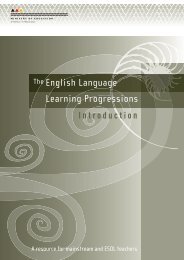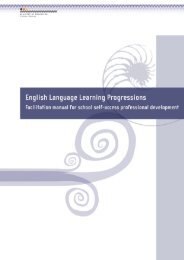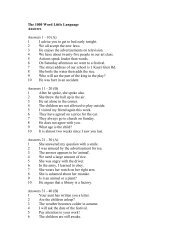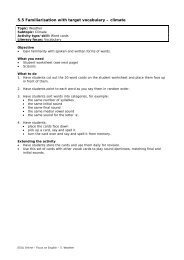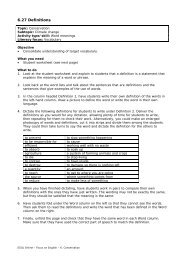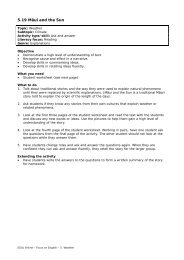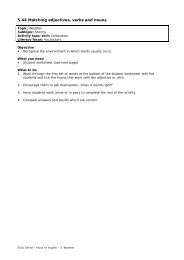ELLP Years1-4 - ESOL - Literacy Online - Te Kete Ipurangi
ELLP Years1-4 - ESOL - Literacy Online - Te Kete Ipurangi
ELLP Years1-4 - ESOL - Literacy Online - Te Kete Ipurangi
You also want an ePaper? Increase the reach of your titles
YUMPU automatically turns print PDFs into web optimized ePapers that Google loves.
Stage 2C/3A<br />
The following sample text is at Stage 2C/3A. It describes and explains a technical process. The<br />
sentences are mostly compound or complex.<br />
<strong>Te</strong>xts at Stage 2C/3A tend to have the following characteristics:<br />
– ideas arranged into paragraphs;<br />
– support from diagrams, illustrations, or photographs;<br />
– topics that are developed in depth, using linking words to connect ideas;<br />
– varied high-frequency words and some technical or topic words that are not easy to infer<br />
from the context;<br />
– simple, compound, or complex sentences, sometimes containing passive constructions or<br />
direct speech.<br />
Other examples of texts at Stage 2C/3A include those found in the Junior Journal or in Part 1 of the<br />
School Journal.<br />
Sample text<br />
Extract: Gibbison, Sue (2003). “Moving Old Houses”. Junior Journal 28.<br />
Wellington: Learning Media, page 17.<br />
Topic: Explaining how a house is moved to a new location<br />
<strong>Te</strong>xt type: Explanation<br />
Audience: A reader of any age<br />
Topic development<br />
The topic is developed with a<br />
question (as a heading at the top),<br />
which is answered in the text<br />
below. The text preceding this<br />
excerpt answers the questions<br />
“Where do the old houses come<br />
from?” and “Why do people move<br />
old houses instead of building new<br />
ones?” This section of the text<br />
explains how the old houses are<br />
moved.<br />
Language structures<br />
The sentences are mostly complex,<br />
for example, Then it is joined<br />
together again (main clause) when<br />
all the pieces get to the new section<br />
(subordinate clause), or compound<br />
complex (If a house is too wide for<br />
the road, it can be cut in half or<br />
thirds and moved in pieces).<br />
Moving Old Houses<br />
Wouldn’t a house get damaged<br />
from being loaded on and off trucks?<br />
Houses built from wood are very flexible and can<br />
bend quite a lot. If a house is too wide for the<br />
road, it can be cut in half or thirds and moved in<br />
pieces. Then it is joined together again when all<br />
the pieces get to the new section.<br />
Sometimes there are accidents, and windows get<br />
broken or parts of a house fall off. These things<br />
are fixed up when the house is safely on its new<br />
piles. Fireplaces are always taken out before the<br />
house is moved. They are put back again when<br />
it’s on its new section.<br />
34





